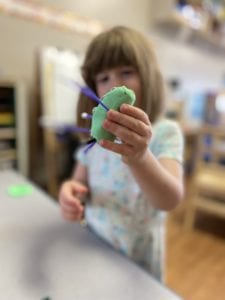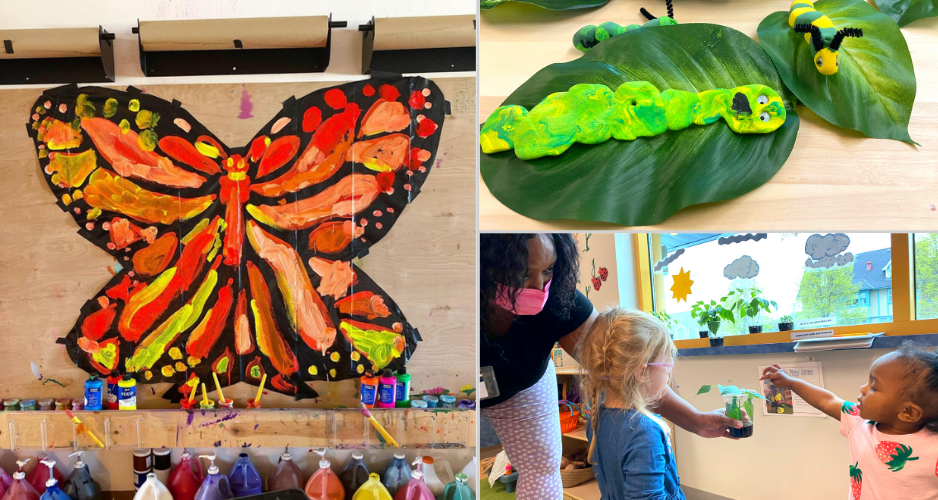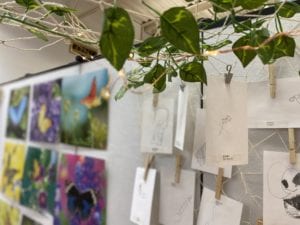Flowers are blooming. The days feel longer. Spring is here!
In tandem with new life emerging and a sense of renewal that the spring season brings, little learners at UICS have been active in exploring the natural world around them. This includes creatures they find on the playground and on pages of literary classics to items they find on their plates and devour during meals….
UICS-St. Mark Center and UICS-North Center teachers are conducting studies about the lifecycle of caterpillars, while UICS-Metro students are growing their own fresh produce.
You might remember reading Eric Carle’s “The Very Hungry Caterpillar” as a child. The story highlights one caterpillar with a big appetite who eats and eats until he makes a cocoon around himself and sleeps until he magically transforms into a magnificent butterfly. 
At UICS, we take often these stories and concepts and incorporate them into interactive projects for our students to experience hands-on learning. Little learners are fascinated by the living things they encounter.
Amanda VanNatta, teacher for the Frogs classroom at UICS-North Center, recently ordered live caterpillars to conduct project-based curriculum surrounding the lifecycle of caterpillars to butterflies and everything in between!
“The students were excited about the caterpillars and checked on them every day to see the progress,” Amanda described.
The caterpillar study allowed the students to note the changes they saw and develop their own hypothesis about what was next for these fuzzy squirmy creatures.
Brianne (Bri) Pegg, UICS-St. Mark Center Arts Coordinator incorporated special arts curriculum for her students around a similar study of these transformative insects.
Upon receiving live caterpillars, Bri’s students created clay models of caterpillars, illustrations about the cocoons’ appearances, and large trash bag monarch and painted lady butterflies.
“We make observations through art,” Bri explained. “Students are unable to write yet, and this is a way for them to process and report their learning in the only way they can right now.”
Amanda shared that her students enjoyed learning about something they can relate to in real life.
“The students got to see the caterpillars turn into butterflies. It’s not like other interests they have like dinosaurs or unicorns, for example, where they can’t touch them or experience them. Experiences like these let the children see something change and evolve first hand.”
“We feed them ‘til they get big and bigger. Then they go into cocoons. Then they turn into BIG butterflies.” shared Amanda’s student, Arilah (age 4).
Brielle (age 4) said, “It has been FUN! And we made our own butterflies too.”
Upon sharing information about what they learned, there was some minor disagreement about what color the butterflies might be. Arilah thinks they will be yellow, pink, black, and white while Brielle thinks they will be pink, blue, orange, purple, and white. Don’t worry though…. They promised to reveal the butterfly colors as soon as they emerge from the cocoons!
These projects have done much more than educate about the lifecycle of caterpillars. In addition to the scientific exploration of a caterpillar’s lifecycle, students are granted the opportunity to celebrate the wonder and beauty of nature, along with further expanding their social emotional development.
“Any chance we are able to have other living beings in the studio is an opportunity to teach empathy for other life, no matter how different, fragile, or seemingly insignificant they may seem.” shared Bri.
UICS-Metro toddler teachers, Paula White and Marissa Harrell agree and have been leading their students through an interactive project of growing green beans in the window sill.
“One day at lunch, the students were opening up green beans on their plates to see the bean and wanted to know how it got there,” Paula explained.
“We decided to use this as a learning experience to show them how green beans grew from seeds and ended up on our plates!”
Learning experiences like these offer children ongoing opportunities to appreciate nature, make observations, and revel in the incredible world around them. Just as caterpillars experience incredible metamorphoses and seeds grow, our little learners do as well.
At UICS, we encourage our students to explore, ask questions, and expand their thinking. Immense enthusiasm is exuded when our students can relate classroom lessons to the real world. They are given the knowledge and confidence to flourish and apply what they’ve learned in the classroom to what they discover outside in the world.
Like the very hungry caterpillar, we encourage a hearty appetite. Instead of leaves and fruit like the insatiable caterpillar, we encourage a hunger for life-long learning at UICS!



